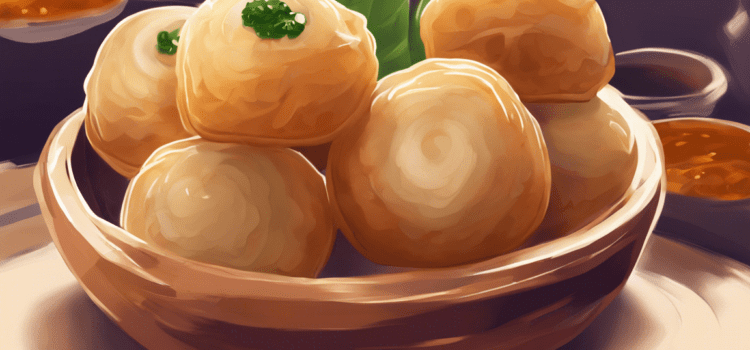Introduction
India’s culinary landscape is as diverse as its culture, with each region boasting its unique flavors and dishes. One such iconic street food that has captured the hearts and taste buds of millions is Pani Puri, also known as Golgappa in some regions. This popular snack is a flavorful explosion in your mouth, combining crispy puris (hollow fried bread) filled with spicy, tangy, and sweet water, along with a medley of fillings.
The Origin of Pani Puri
Pani Puri traces its roots back to the northern regions of India, particularly in the states of Uttar Pradesh and Bihar. Over the years, it has spread across the country, becoming a beloved street food item enjoyed by people of all ages. The crispy puris are made from semolina or wheat flour, rolled out into small circles and deep-fried until they puff up, creating the perfect vessel for the flavorful water and fillings.
The Components of Pani Puri
The beauty of Pani Puri lies in its layered flavors and textural contrast. Let’s break down the components that make up this tantalizing snack:
-
Puri: The crispy, hollow sphere that forms the base of Pani Puri, providing a satisfying crunch with each bite.
-
Pani: The star of the show, Pani is the flavored water that gives Pani Puri its unique and refreshing taste. It is a blend of mint, coriander, tamarind, green chili, cumin, and other spices, creating a balance of spicy, tangy, and sweet notes.
-
Filling: The puris are stuffed with a filling typically made of boiled potatoes, sprouted mung beans, chickpeas, and spices. Each vendor may have their variation of fillings, adding a personal touch to the dish.
-
Sev: Thin, crispy noodles made from chickpea flour are often sprinkled on top of the puris for added crunch and flavor.
-
Garnishes: A sprinkle of chaat masala, chopped coriander, sweet tamarind chutney, and spicy green chutney elevate the taste of Pani Puri, making each bite a burst of flavors.
Variations of Pani Puri
While the classic Pani Puri recipe remains a favorite among food enthusiasts, there are several intriguing variations that cater to different tastes and preferences:
-
Ragda Pani Puri: In this variation, the puris are filled with ragda, a tangy and spicy curry made from white peas. The addition of ragda adds a rich and savory element to the dish.
-
Dahi Puri: For those who prefer a creamier texture, Dahi Puri offers a delightful twist by filling the puris with whipped yogurt along with the traditional fillings. The yogurt adds a cooling contrast to the spicy water, creating a harmonious blend of flavors.
-
Fruit Pani Puri: A modern take on the classic, this version replaces the traditional filling with a mix of fruits such as pomegranate seeds, mango, and pineapple. The sweet and tangy fruits complement the spiced water, offering a refreshing and fruity twist to the dish.
Health Benefits of Pani Puri
Contrary to popular belief that street food is unhealthy, Pani Puri, when prepared hygienically, can offer some surprising health benefits:
-
Rich in Fiber: The combination of sprouted mung beans and chickpeas in the filling provides a good dose of fiber, aiding in digestion and promoting gut health.
-
Antioxidant-Rich: The mint, coriander, and spices used in the water are packed with antioxidants that help fight inflammation and boost immunity.
-
Hydration: The watery nature of Pani Puri helps keep you hydrated, especially during hot summer days, preventing dehydration.
FAQs About Pani Puri
- Is Pani Puri spicy?
-
Pani Puri can vary in spiciness depending on the vendor and individual preferences. You can adjust the spice level by controlling the amount of green chilies in the water.
-
Can I customize the fillings in Pani Puri?
-
Yes, you can experiment with different fillings such as boiled chickpeas, sprouts, black gram, or even paneer to suit your taste.
-
Is Pani Puri gluten-free?
-
While the traditional puris are made from wheat flour, you can opt for gluten-free alternatives such as buckwheat flour or rice flour to make them gluten-free.
-
Are there any vegan variations of Pani Puri?
-
Pani Puri can easily be made vegan by ensuring that the fillings and water do not contain any animal products. You can use vegan yogurt in Dahi Puri and omit any dairy-based ingredients.
-
How can I ensure the hygiene of street food like Pani Puri?
- When enjoying street food like Pani Puri, look for vendors who maintain cleanliness, use safe water for preparations, and handle the ingredients with care. Opt for vendors with a high turnover of customers for fresher food.
Conclusion
Pani Puri is not just a snack; it’s an experience that tantalizes your taste buds and leaves you craving for more. Whether you savor the classic version or venture into creative variations, the essence of Pani Puri lies in its ability to bring people together over shared moments of culinary delight. So the next time you’re out exploring the streets of India, don’t miss the chance to indulge in this flavorful delight and immerse yourself in the vibrant world of Pani Puri.

